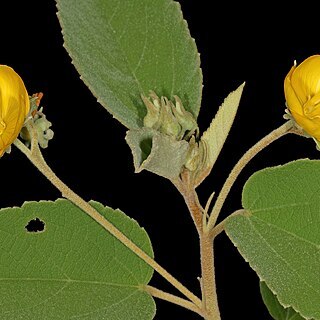Shrublet about 65 cm tall; stem erect from a comparatively slender tap-root, branched; branches erect and spreading, new growth greyish stellate-tomentose and sometimes with bunched light to dark brown hairs intermixed. Stipules subulate, 0.5-1.7 cm long. Leaves greyish stellate-tomentose on both surfaces, sometimes more thinly so on the upper surface, lower surface sometimes with light to dark brown bunched hairs, especially on the prominent nerves, broadly to narrowly ovate-oblong, 3.5-10 cm long, 1.5-6 cm broad, narrowing towards a broadly rounded apex, rounded to subcordate at the base, margins crenate-serrate; petiole 1-2.5 cm long, stellate-tomentose. Inflorescence axillary, peduncle straight, suberect up to 5 cm long, 3-or more-flowered near the apex; pedicels 0.6-1 cm long. Epicalyx-bracts ovate (rarely narrowly so), shorter than the calyx, rounded at the base and with a very short broad claw, abruptly acuminate above into a caudate-like upper half, tomentose on both surfaces. Calyx with lobes lanceolate, gradually narrowing to the acute apex, 1-1.5 cm long, stellate-tomentose on the outside only. Petals usually longer than the epicalyx, obovate, broadest at apex. 1-1.5 cm long. Stamens with filaments and anthers about 3.5 mm long; staminodes 7 mm long. Ovary subglobose about 8 mm diam., densely tomentose; style 6-10 mm long, branches 1-2 mm long; ovules 6 in a cell.
More
Shrublet with the habit and general appearance of M. forbesii but differing as follows: herbaceous parts greyish-tomentose and not so markedly ferruginous-hairy on the stems and nerves; bracts of the epicalyx abruptly acuminate or even caudate at the apex and often noticeably cordate at the base; style from 0·7–1·1 cm. long rather than 0·1–0·3 cm. long; and seeds slightly rugose.

